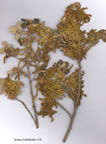| Fagaceae |
 Quercus brantii |
| Quercus L. Quercus brantii LINDLEY Ömür: Çok yıllık Yapı: çalı veya küçük ağaç Hayat formu: İlk çiçeklenme zamanı: 8 Son çiçeklenme zamanı: 9 Habitat: saf komuniteler, diğer Quercus türleri ve Pinus brutia, Styrax, Paliurus ile beraber Minimum yükseklik: 350 Maksimum yükseklik: 1700 Endemik: - Element: İran-Turan Türkiye dağılımı: D. ve GD. Anadolu Genel dağılımı: Suriye Çöl, K. Irak, B. ve G. İran Bulunduğu kareler :B6 B7 B8 B9 C6 C7 C8 C9 C10 |
| Q. brantii Lindley in Bot. Reg. 26, Suppl. 41 (1840). Syn: Q. persica Jaub. & Spach, I11. Pl. Or. 1:109, t. 55 (1843); "Q. aegilops L." subsp. brantii (Lindley) Camus, Les Chênes, Texte 1:544(1936-38);Q. brantii Lindley subsp. persica (Jaub. & Spach) O. Schwarz in Notizbl. Bot. Gart. Berlin 13(116): 19 (1936); Q. brantii Lindley vars. belangeri (DC.) Zohary, persica (Jaub. & Spach) Zohary & marasiensis Zohary in Bull. Res. Counc. Israel 9D, no. 4: 174, 175 (1961). Ic: Kotschy, Die Eichen t. 28 (1861), as Q. persica; op. cit., t. 31 (1862); Feddes Rep. Sonderbeih. D: t. 59, 60 (1936); Fl. Iranica 77: t. 7 (1971). Figure 20. Map 87. Deciduous shrub or small tree to 6(-10) m with greyish, rather smooth barkand rounded crown; young shoots densely yellowish-brown tomentose. Buds ovoid, c. 4 mm, tomentose. Leaves distributed over shoots, ± regularly ovate-oblong, 6-10(-13) x 3-6 cm, cordate, ± regularly serrate with 8-14 pairs of acuminate scarcely aristate (1-2 mm) teeth; intercalary veins absent; upper surface dull green with numerous small dendroid-stellate hairs, lower pale yellowish-brown, densely stellate-tomentose; petiole 0.5-2 cm. Peduncle nearly absent, to 5 mm, sturdy. Fruit maturing in second year. Cupule hemispherical, c. 25-30(-35) mm diam., densely pubescent; scales broadly rhomboid, uppermost much elongated, often filiform, spreading-recurved; acorn ± included to c. 1/3 exserted, apically ± convex. Fr. 8-9. Forming pure communities, with other Quercus species (Q. infectoria subsp. boissieri, Q. libani, Q. cerris, Q. coccifera), with Pinus brutia, Styrax, Paliurus, often on limestone slopes, 350-1700 m. Described from [Turkish] Kurdistan, Brant. E. & S.E. Anatolia. B6 Malatya: Darende to Akcadağ, 1370 m, D. 21908! B7 Elaziğ: Hazar G., 1150 m, McNeill 475! B8 Sürt: 37 km from Siirt to Baykan, 850 m, D. 43175! B8/9 Bitlis: Baykan to Bitlis, D. 22164! C6 Maraş: Maraş to Göksun, nr Yemiş Da., 600 m, D. 27515! C7 Urfa: Karacadağ, Siverek to Diyarbakir, 1250 m, D. 28298! C8 Mardin: Mardin to Mazidaği, T. Baytop (ISTE 18230)! C9 Hakkari: c. 40 km from Çukurca to Hakkari, 950 m, D. 44815! C10 Hakkari: Cilo Da., Zab gorge nr Dezi, 1600 m, D. 24015! Syrian Desert, N. Iraq, W. & S. Iran. Ir.-Tur. element. Close to Q. ithabur-ensis subsp. macrolepis but usually distinguishable by the ± regularly serrate leaves (Figure 18). Q. brantii varies greatly in the size of the cupule and the size and posture of the cupular scales; several varieties have been recognised based on this, apparently completely intergrading, variation. It hybridises, inter alia, with Q. libani, and some forms certainly appear to be what was described as Q. oophora Kotschy (Die Eichen t. 26, 1862), others as Q. vesca Kotschy (op. cit. t. 36). Additional synonyms of Q. brantii based on Iranian material are given by Menitsky in Fl. Iranica 77:13-15 (1971). |